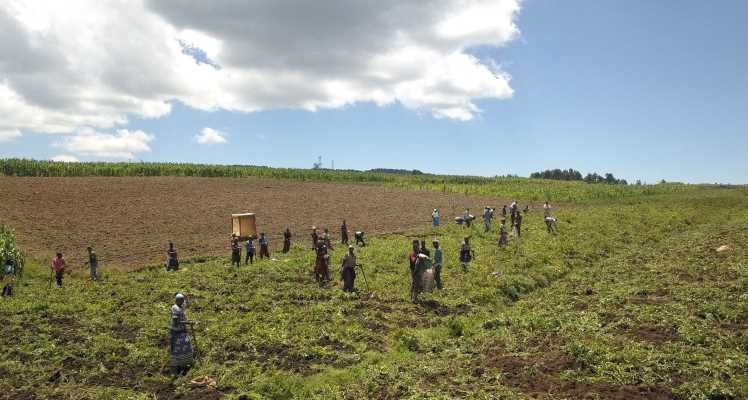Agroforestry –Aerial over farmland in Kenya: Image: Henry Graham (BBC)
Soil is a finite resource, and it can take up to 1,000 years to produce a single inch of top soil. Over 90% of the food that feeds both humans and animals relies on soil as its foundation, but soil is now under threat like never before. It’s estimated that, by some measures, up to 40% of agricultural soils are degraded in some way, and that figure is rising.
It’s the first five to ten inches of soil that contain almost all the precious nutrients, but this top soil is at the mercy of the elements. Amongst other threats, it can be physically blown away, washed away, or have its nutrients leeched away.
In episode five of the BBC World News and bbc.com series, Follow the Food: The Promised Land, renowned botanist, James Wong, investigates how some farmers are exploring radical new methods, hoping not only to stop the decline, but even reverse the damage.

Regenerative agriculture
Regenerative agriculture rehabilitates the ecosystem of a farm, and improving soil health is at its heart. Tilling, or turning over the soil, is stopped or reduced, crop rotation is encouraged, along with diverse protective cover crops. Agricultural chemicals are cut back, and livestock may be introduced.
Jeff Aalund, an oat farmer in North Dakota, is trying a technique called regenerative agriculture. He said: “I like to farm with more focus on what I’m passing onto the next generation, and doing it with the attitude that you’re doing something good for the land, and you’re doing something good for yourself and your family. I was sceptical at first, but I’ve seen what it can do and I’m absolutely sold on this type of farming. In just one season, I couldn’t believe how much the land changed. On the soil structure, the way the crops responded the next season.”
Sections of Jeff’s farm were so bad, he was unable to grow anything, but that’s changing fast, and it’s a solution backed by global food giant, General Mills, a USD $17 billion food company, and one of the oldest in the United States.
Jeff Harmening, Chairman and CEO at General Mills, said: “We are the first company, globally, to set a target – we want to have regenerative agriculture on a million acres by 2030. When we talk about regenerative agriculture, we are talking about agriculture that actually regenerates the soil – that helps sequester carbon, that helps maintain water, and maintains nutrients in the soil. If you think about 90% of the top soil being degraded over the next 30 years, we need to act now.”
General Mills has been providing farmers, like Jeff Aalund, with mentors to help them switch to the new techniques.
Harmening added: “We have about 45 oat farmers we’re working with, along with experts. We work with those farmers to determine what kind of crops they ought to develop. They have every reason to want this to work because the climate is changing so much – they see more rain, they see more drought. What we’re planning on is showing the world that this actually can work, so it’s just a start, but it’s a good start and a big start to prove the theory of the case.”

Land degradation
Ibrahim Thiaw, Executive Secretary, United Nations to Combat Desertification (UNCCD), said: “According to the latest science, one in four hectares of ice-free land in the world is severely degraded, and up to 70% of our land has been altered by human activities. Up to 2.1 billion people in the world are directly affected by land degradation, and half of humanity – more than 3 billion people – are indirectly affected in some way. That’s a major challenge we’re facing now. The good news is that there are solutions; we are still able to reverse the situation.”
Dr Susan Chomba, Regreening Africa Project at World Agroforestry, said: “In Africa, around two thirds of our agricultural land is extremely degraded. That means declining agricultural productivity and, therefore, less income for farmers. It also means farmers are constantly abandoning areas where productivity is low, and moving to virgin lands that can be able to produce more agriculture.”
Regreening Africa is an ambitious, EU-funded, sub-Saharan project, with agroforestry at its heart. They’re aiming to help 500,000 households restore a million hectares of agricultural land by 2022 in countries including Senegal, Mali, Niger, Ghana, Ethiopia, Kenya, Somali and Rwanda.
“Regreening Africa is a programme that is looking at the problems of land degradation. The African continent has huge areas that are arid and semi-arid, and in those areas, you will see just small short shrubs that don’t seem to grow into trees. There’s a lot of potential in converting those shrubs into trees, and tree planting is a win-win scenario because they take carbon from the atmosphere and convert it into the biomass that they are growing in. It’s extremely critical for climate change,” said Dr Chomba.
Samwel Ondiek Sana, a smallholder farmer in Ogongo and a participant in the programme for the past three years, said: “When I came to my farm, my farm was bare – it was deserted and degraded – and I thought I should change it. I embraced the issue of planting trees, and started with the Calliandra trees because it has a lot of uses. It improves soil fertility and it helps with soil erosion. It cools the running water, and it provides food for my animals. It’s quite important for my farm.”
After planting Calliandra trees on the border of his farm, Samwel noticed big changes in his soil, and he is now a leading figure in his community, training others in agroforestry and natural regeneration methods to protect the soil.
Source: BBC World News.








